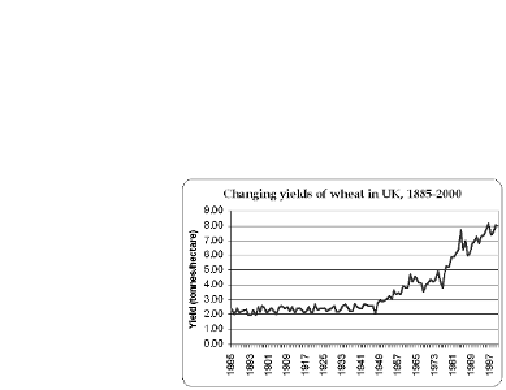Agriculture Reference
In-Depth Information
3 After the progress made by Sue Heisswolf and Kevin Niemeyer with the
Brassica Improvement Group, Brad Scholtz and colleagues (1998) found that
the more pesticides applied to maize in Queensland, the lower the yields; and
the less spray, the higher the yields. This echoes earlier research by Peter Kenmore
and colleagues in Asia in the 1980s, who found that pest attack in rice was
directly proportional to the amount of pesticides applied - pesticides killed the
beneficial insects that were exerting good control of pests.
4
Source: DEFRA statistics
Figure 5.1
Changing Yields of Wheat in the UK, 1885-2000
5 See Fuglie et al, 2000; USDA, 2001a
Table 5.1
Measures of Increasing Productivity in US Livestock Production
1955
1995
% increase
Beef cattle (kg beef/cow)
267
327
23
Pigs (kg pork/sow)
357
680
90
Dairy (kg milk/cow)
2643
7444
182
Broilers (kg/bird)
1.39
2.11
52
Layers (eggs/layer/year)
192
253
32
Source: Fuglie et al, 2000
6 In the US hog industry, just 2700 farms now have half of all American
pigs. The other half are found on 140,000 farms, down from 900,000 since
1970. In the egg industry, 95 per cent of all 270 million layers are managed by
300 egg-producing operations, each owning flocks of 75,000 or more. Just ten
companies control nine-tenths of all poultry production. Similar polarizing
trends are evident in the European Union, where 6 per cent of farmers produce
60 per cent of cereals, and 15 rear 40 per cent of all farm animals. In the UK,
just 52 pig holdings rear 80,000 pigs, while another 40,000 holdings raise
170,000 pigs in herds of less than 20. In the broiler chicken sector, 330 holdings
raise 67 million broiler chickens (66 per cent of the total), while 720 holdings



















Search WWH ::

Custom Search